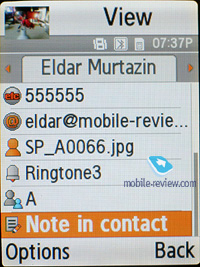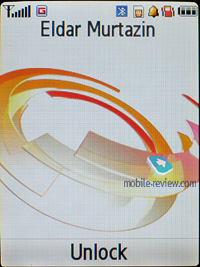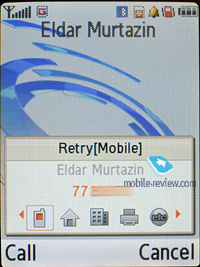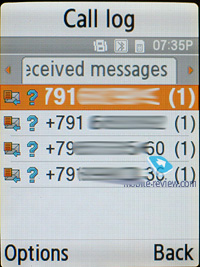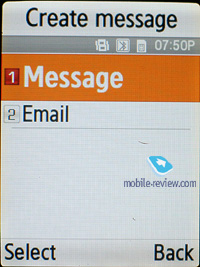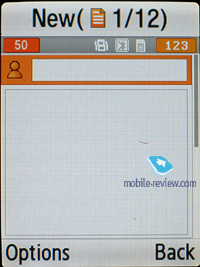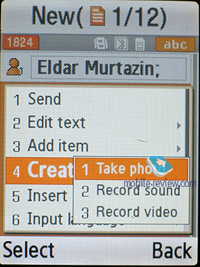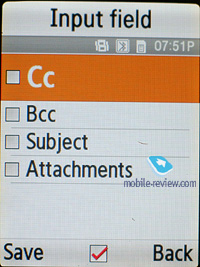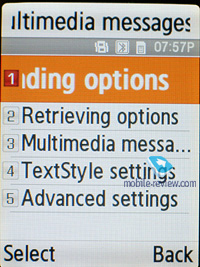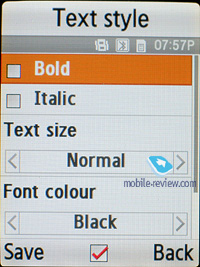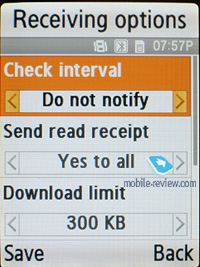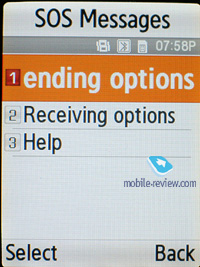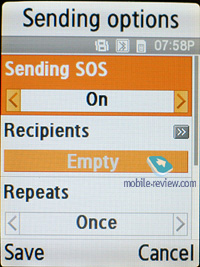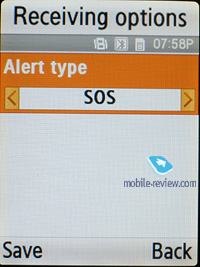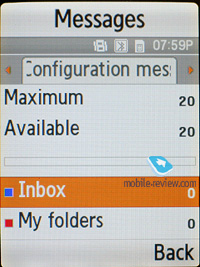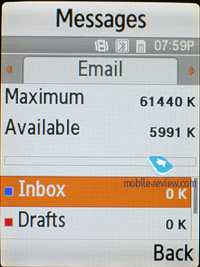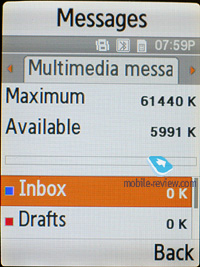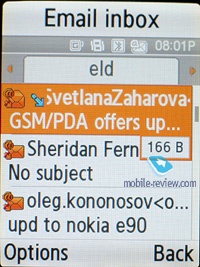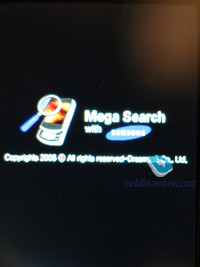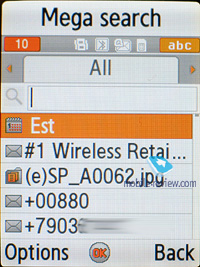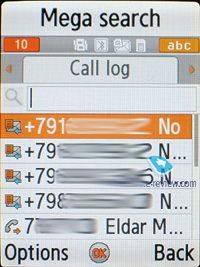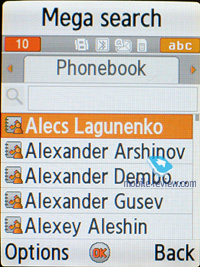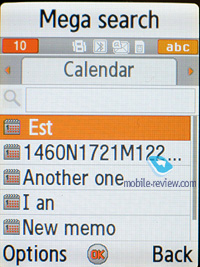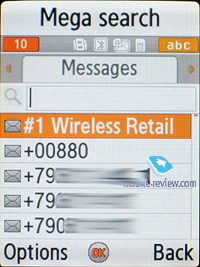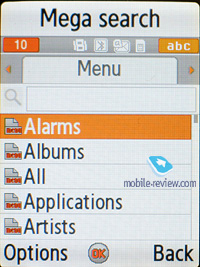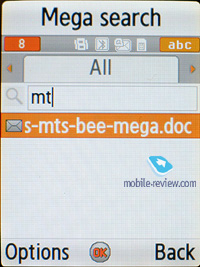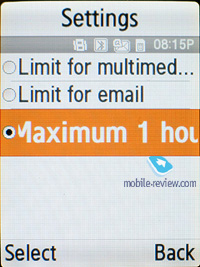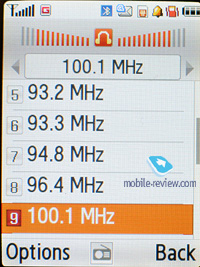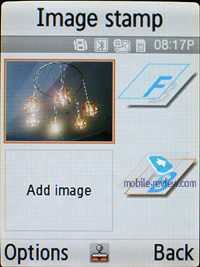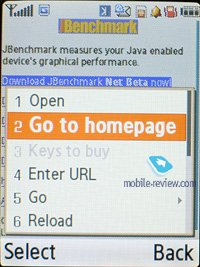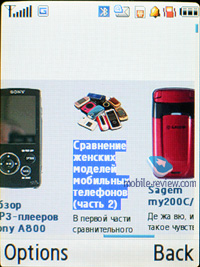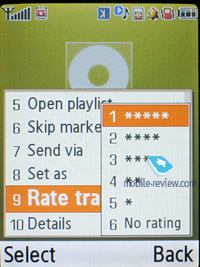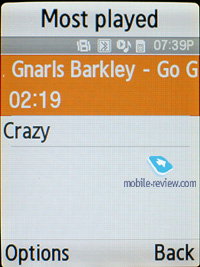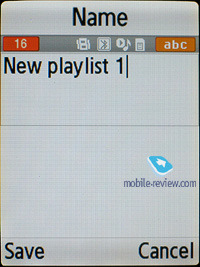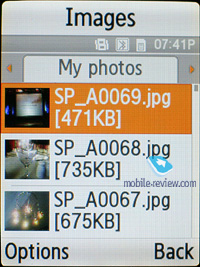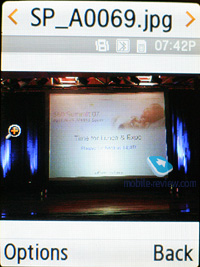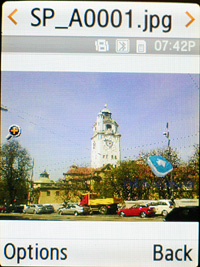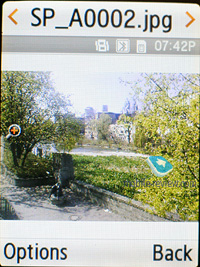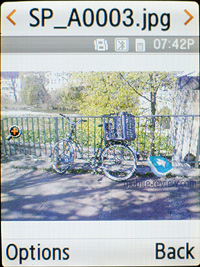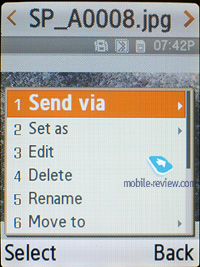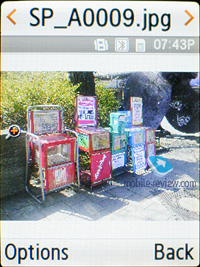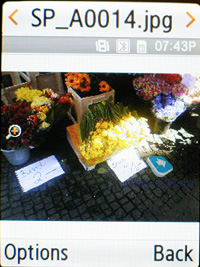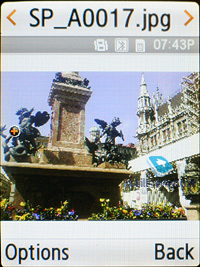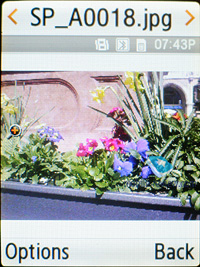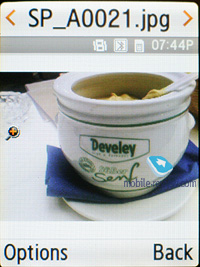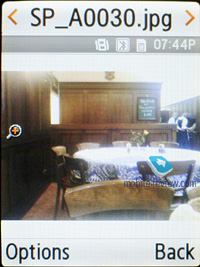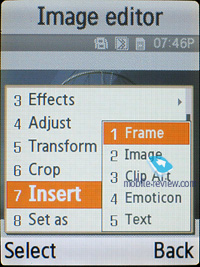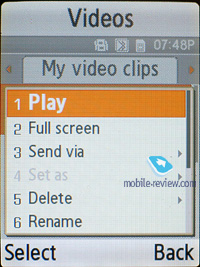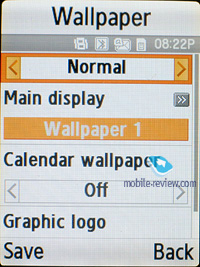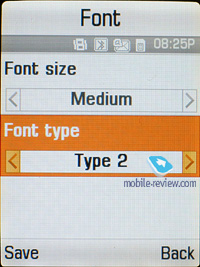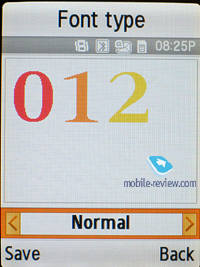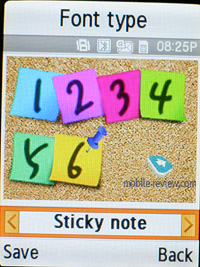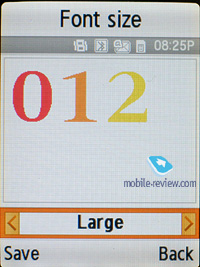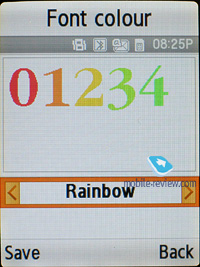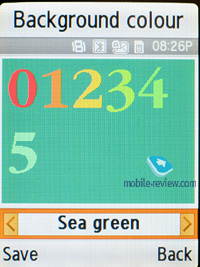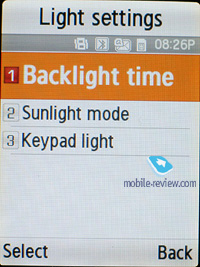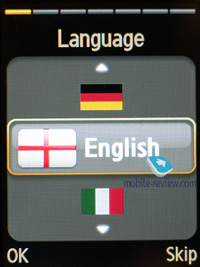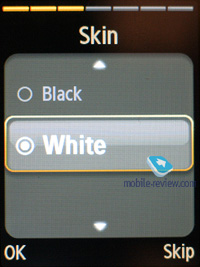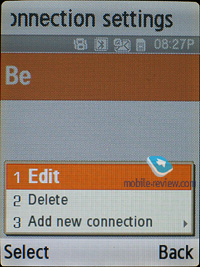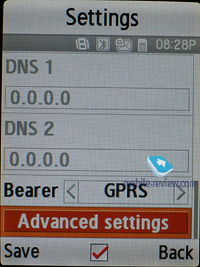|
|
Review of GSM-handset Samsung U600 (Part 2)
Review of GSM-handset Samsung U600 (Part 1) >>>
Unlike all previous models, the Samsung U600 utilizes Smart Search, a new engine for searching any information regardless of the storage space; revamped SMS/MMS-editor, reinforced MP3 player, FM radio with RDS and also updated built-in browser. There are also some more subtle items on the change log. By and large, they have made a great job enhancing the phone’s functionality – after all these face-lifts the device looks much different from what the company has been offering to date.
Menu
The main menu can be viewed as a grid (3x4) or in the list form. Unlike the predecessors its grid appearance features one line on top of the default three. All sub-menus have horizontal lists, in case there’s sub-menu, you will see pop-up list on the right of highlighted item. You see which items are stored underneath, and once you press OK button – you will get there. In case you lean navigation key on the right or on the left, you will be able to access corresponding item at once. Ergonomics of such solution is evident, at least one key-press will be saved, and this is interesting solution developed by Samsung.
While surfing the menus you can take advantage of last item memorization in every sub-menu and the main menu. The Handset will “remember” which function you addressed last time, and will highlight it automatically next time you enter same menu item. For example you selected call list in main menu, done some operations in it, and next time you enter main menu you will have it highlighted in first place. But that’s not all; once you access it again you will see that sub-menu item which was addressed last will be highlighted too. It seems to be a simple thing, but it is not present in handsets produced by any other manufacturer.

When hovering over one or another item in the list you will see it highlighted, and font size (which is big already) will be increased.

Shortcut number navigation is supported, but that’s not all options of menu navigation. You can bind four different applications from the list, offered by manufacturer (you will not be able to bind java applications). Leaning navi-key up will always activate My Menu, this is horizontal scroll with list of items. This list is identical to that for simple shortcuts.
uWorld (formerly known as Living World). This is a selection of own wallpapers for each country (major cities might get unique wallpapers in the future, though it is not quite evident). When you will be in Moscow you will see Kremlin wharf and triumphal arch in case you’re in Paris, as for London – house of parliaments, and so on. Besides graphical assignation manufacturer decided to modify wallpaper depending on time of day: in the morning you see sun, and in the evening you see blinding lights of Kremlin wharf, cars will have their headlights turned on.
Time is not the only event that can be morphed into graphics. For example network reception level: good signal – sky is blue, no signal or weak one – sky is covered with clouds. At first you don’t pay much attention to this tiny feature, but after a month you will look on the sky instead of the standard bar, information reads instantly.
For new messages, missed events or alarm clocks there is a special way of displaying, which is powered with standard, traditional pop-up window with text. In daytime such events will be demonstrated with help of airplane that will fly through the sky, and in the evening that would be fireworks. Color will change according to event type. At a glance this system looks kind of complicated, especially during its description, but in reality it is crystal clear and understandable.
When dialing a number you will see a small image with main theme displayed and animation of the dialed number.

Phonebook. Contacts can be accessed by pressing right soft key; you will see a list that contains all entries from both SIM-card and phone’s memory. By default first name is highlighted, and you are offered the phone number in service text line (SIM-card entries are displayed with corresponding icon). Fast name search by first letters is supported; there can be up to twenty of those, for any language. Once you press OK key you will go into detailed view of the selected entry. There you will see a thumbnail, if any. It can be an image, a photo or a video clip. Each entry can have up to 5 phone numbers of different types (cellular, office, home, fax other), one of them will be main number (by default it is the first one you entered). All fields are locked.
There are two lines for First Name and Last Name (search is performed only by the former), fields get summed when displayed, Name comes first. For example Eldar Murtazin will be shown only in this order. Length of each field is 20 characters for any supported input language. You can also switch languages on the go when entering a name.
All entries, regardless of language, are sorted out in the following way – all contacts with headings made in a local language (Russian, for example) go first and then those with names in English. This is rather convenient and handy list sorting system. Taking into account fast language switch option during the search, it’s clear that no language will spoil the experience of working with this phone. The list can’t be sorted by first or last name, which is a letdown, characterizing Gumi’s products.
But let us return to the information entered for a contact. Apart from phone numbers, e-mail address (there may be several of them), a little text memo can be submitted on top of all that. Any music file as well as MP3's can be picked as a ring tone for a contact. Three caller groups are provided by default with the possibility for creating any number of additional groups, setting a personal melody and image for each (by default there are three groups). SMS alerts are also customizable.
The phonebook is capable of holding up to 1000 contacts with filled in data fields. Even if all the available blanks are not used, the cap won’t get any bigger and will still make one thousand. It is possible to specify in the settings where all new numbers should be kept by default. There is also an option for moving entries from the SIM-card although the reverse action is denied. According to the developers, PC (MS Outlook in particular) is best for data synchronization with the D900i. Any contact in the form of SMS/MMS, mail message or other text file can be quickly sent through Bluetooth to another device. There are no problems with sending and the phonebook entry gets beamed to another device, where it is read without any trouble.
The phonebook may contain a business card as well, though its structure copies all the fields found in a regular contact in the phone book.
There can be up to eight numbers in the fast dial list; separate numbers tied up with a single contact may appear on this list as well. The chosen entry (not of the phone number type) is displayed on the buttons as the subtitle.
You can create any number of caller groups, assign up to 20 contacts and customize them with a picture and tune.
When receiving a call, a picture occupies not the entire screen, but only a part of it, however it still takes up a considerable area.
Call log. Each of the given lists contains up to 30 phone numbers. There is a combined list of all the last calls with an icon indicating call type. Pressing the navi-pad horizontally, you can switch quickly between the lists. The date and the time of a call without special note of duration are displayed in the extended view for separate entries. Calls from/to one number are grouped up, so that the number standing next to the call specifies total number of calls made. In order to access duration data you will need to call up detailed information on desired item. As always, the overall time of the calls and their cost can be viewed in this menu (in case the service has been enabled).
Messaging. Much like other makers, over at Samsung they have forgo that artificial division into SMS-MMS types – you just start composing a message, and only then, depending on the contents, it is attributed to SMS or MMS. The menu still holds an option for switching message into MMS mode (for example when you need to send only text, but to an e-mail address, without calling up the bundled client).
The phone memory can hold up to 1000 messages simultaneously; the handset supports EMS standard compatible with Nokia Smart Messaging. T9 text input comes in handy and is easy to use. While choosing recipient, you can either select a telephone number from your contacts or pick one from the call lists or groups. All messages are manageable, this means you are at liberty to move a certain number to your black list, in order to make sure all messages coming from that phone number will be deleted automatically; possibility for moving messages to any own folder is also at your disposal. For e-mail you can move not only addresses to the blacklist, but unwanted subjects as well.
One of the options on the menu is Vivid Message, which allows viewing a message in 3D mode – the handset converts frequently used words into graphics, for example having typed “Kiss you”, you will see lips, blowing kisses. On the face of it, a simple add-on that sometimes puts up really amusing effects.
There are no size restrictions on received messages, though an outgoing message’s size is limited to 295 KB. As for additional services available with the U600, advertising messages rejection and message retrieval type options are onboard. All messages are stored in general dynamic memory, the same goes for e-mails.
Also there is a useful function for sending SOS-messages – when activated, should you find yourself in an emergency, after pressing the volume key four times, the message «I am in emergency. Please help me» will be sent to contacts submitted earlier, all incoming calls from these numbers upon sending the emergency message will be picked up automatically. Recipients (not more than 5), as well as number of Repeats may be set up manually, while text of the SOS-message is not manageable.
The bundled mail client is standard in all its components – 5 accounts and the maximum of 100 incoming messages; attachments are also handled by the phone, though there are also several caps – there’s no way you can receive a file more than 5 Mb big, or send one with size exceeding 300 kb. Received files can be viewed via Picsel Browser.
Planner. There can be up to 300 different events of three types (3x100) - meeting, affair, anniversary. The day and the time as well as end time of the even are indicated for each entry. Alert signal and its duration can be adjusted to your liking; repeatable events are available for setting up (at that repeat time is also manageable as well as the exceptions). The weekly and the monthly calendar views are very convenient with each type of the event having its own color.
Tasks – a standard list of tasks with the ability to specify priority. Maximum capacity of this section makes up 100 entries.
Speaking of the organizer’s shortcomings, I cannot overlook the fact that when typing date and time for an event, the end time doesn’t change, which badly hurts its ease of use – other manufacturers make the due time shift automatically (by default any event takes one hour).
Applications
Smart Search. Initially this application was known as Mega Search, but it ended up with a new, much more interesting name. This is a very unique utility having no counterparts built into ordinary phones – S60 smartphones’ Search is the most resembling tool. The application allows looking for text and numbers within the following categories:
- Menu – search by menu items;
- File system – search by file name;
- Messages – search in the message body (SMS/MMS and e-mail);
- Calendar – any type of entries;
- Games – search by game title;
- Phonebook – by first name, last name, or other text fields;
- Call log;
- In all categories;
For example, you type “mu” and want to search for it in all categories – then you will be presented with all messages from Murtazin Eldar, entry in the phonebook, Music menu item, and so forth. The search works quite speed. Regrettably, it can’t be used for looking up in MS Office documents and PDF – if only it could, it would be much more valuable. But even what it is feels very gratifying. Having a lengthy contact list, a pile of SMS-message, this search is the best way to find something.
FM-radio. You can store up to 20 radio stations in the memory; the range of available frequencies is 87.5-108 MHz. Also, you can enjoy auto-tuning, but particular channels cannot have own names attached – they are always shown as the frequency, numbers. The radio can work in handsfree mode, plus enables you to set it up as alarm clock, but regardless of how you are going to use it, a plugged-in headset is a must, since it doubles as an antenna. On top of that, the radio here brings a quite unusual feature alongside – there can be up to three sound notifications, some sort of alarm clocks. How it works: you specify date and time, frequency, and then the radio turns on automatically when the time is right, so as to ensure that you don’t miss the broadcast you wanted to hear. The radio implementation is fine, although it doesn’t pick up just all stations equally well, but on the balance, it is quite competent, in comparison to other vendors’ offerings. The radio can be minimized.
RDS here displays only the station’s name in the general list, no advanced options aavailable.
Voice recorder. You can record up to several hours of voice memos with the number of files being unlimited. Basically, limitations on recording duration are set by the user himself, though length of a single recording cannot exceed 1 hour. All the files are stored in a separate folder in the memory bank. The recorder performs well during lectures, conferences and presentations – I could even say that it is a partial substitute for a digital tape recorder.
Image editor. A basic picture editor, which allows transforming images by using a variety tools.
Image Stamp. An editor allowing you to overlay one picture with another, leaving a kind of stamp of the latter.
World time is displayed for two chosen cities.
Calculator It divides, multiplies, subtracts and adds and does several more things – quite enough for a mobile calculator.
With the converter, you can operate with different units of measurements as well as with a number of currencies.
Memo – standard text notes.
Countdown time and stopwatch have no bells and whistles.
Java World. The handset comes pre-installed with 6 games, out of which 2 are fully functional (Bobby Carrot, Time Rider II), and four are demo-versions (limited by time or levels). These demos are quite fetching, these can be Asphalt 2 Urban GT, Midnight Pool, Minigolf, Tetris and so on.
The memory volume assigned for Java-applications is unlimited, at that you can remove any of the pre-installed games and upload new over the air (via WAP). Heap size can’t exceed 1,5 Mb, while the application can’t go over 700 Kb.
WAP. The handset comes with a wap-browser version 2.0 (NetFront 3.2), whose fundamental improvement is support for JavaScript, fonts scaling (three types), Smart-Fit (single-column view), full-screen mode (all controls are hidden), page caching. Although it has its own demons, for example doesn’t feel too good in handling formatting of huge pages. But for Samsung’s range it is the best inbuilt browser we have seen so far.
ÌÐ3-player. MP3 player. The integrated mp3 player, supporting random, sequential and cyclic playback, is available on the phone. Mp3 files can be uploaded onto the handset both directly over Bluetooth and through the synch application. There are no limitations placed on tags and names of music files. Bitrates are also not something that really matters – the handset easily deals with all available formats and supports WMA, AAC, eAAC, eAAC+.
The title of the currently played back track is displayed as well as the number of the remaining tracks. The equalizer doesn’t make much sense, as there is no precise adjustment of audio controls (only the possibility to choose from classic, rock, jazz and normal profiles). The tracks can be played through the stereo headset as well as the speakerphone. The volume bar has 10 scales on it. And of course the user can make up own playlists. Player can work in minimized mode.
The player boasts the following filters: all tracks, recently players, most popular, artists, albums, genres and composers. The U600 also flaunts Album Arts support.
Speaking of then new options, the player has obtained the rating system, enabling you to award any track with one to five stars. The maker has driven the integration with Windows Media Player as deep as it has never been before; actually, this manager also sports the rating system. While we were having our quality time with the handset, we came across the issue when the device successfully synchronized with Windows Vista via MTP, yet uploaded WMA files were turned away on a playback attempt. Synchronization with Windows Media Player 10 was never an issue, though.
The bundled headset doesn’t have a jack for plugging in own earphones, yet provides quite adequate sonic experience. Generally speaking, as a music-minded solution, the U600 comes close to Sony Ericsson’s Walkman range, especially as far as the first generation is concerned.
Picsel Viewer. One of the best things about the U600 is Picsel Viewer. To put it shortly, Picsel Viewer is an application that is capable of opening MS Office files (for instance, MS Word, Excel, PowerPoint), Adobe Acrobat (PDF), picture and video formats on the phone. The attraction of this technology is its speed, a 20 MB PDF file will take a couple of seconds to open, then you can quickly page through it, zoom in/out and rotate pages. No editing capabilities, only viewing, but that is pretty much enough, especially considering there is no need in extra conversions.
Apart from viewing data on the screen, an image may be sent to external sources, for instance, a television or projector. A TV-OUT cable is not included into the retail package. One end of the cable sports a miniUSB connector and the other one - three RCA jacks for connecting to external sources. I had a TV-set acting as that external source. Plug all the cables in and connect the phone. And here it is! The menu is shown on the TV screen, moving along the phone menu you see your actions on the screen. Besides documents browsing with Picsel Viewer, you can view any standard applications, full-screen video (3GPs suffer much from blockiness), photos, play games if you like to. The television will not only show the picture but also reproduce the sound from the phone.
Video player. MPEG4 format (audio AAC) is supported, maximum possible bit rate makes up 1.5 Mbps. The handset supports various resolutions up to CIF, however capturing in QVGA resolution (at 30 frames per second) is somewhat better. No extra features are enabled in this player, unless you call rewinding and full-screen mode (by pressing “1” key, the picture can be rotated in two directions) the ones.
Alarm clock. The handset comes equipped with four alarm clocks, each of them can go off on certain weekdays. You can also pick one of the five tunes, or turn to MP3 tracks. In settings it is possible to enable auto switch-on when any event triggers.
File Manager (My files). That’s the place to search for all files such as music, pictures, video and sounds. Any uploaded file gets stored here. The disadvantage is that files sometimes are not displayed in the list immediately - in that case you will need to leave the menu and enter it again.
Files and folders can be viewed either as a list or thumbnails. You can mark any number of files. The handset supports Move, Copy and Delete operations, as well as various types of sorting (by type, name or size)
Memory card’s file structure is a slightly different story, as it can be accessed through the main menu, where each item features “Memory card” option.
Settings. This item boasts a standard set of options inside - font color in the standby mode, password protection of selected sections (messages, short messages, organizer, etc.), backlighting duration and brightness, dialing display (no custom animations are available, one is assigned to the default theme – uWorld). Calling up Security item allows protecting certain functions and menus with password.
Backlighting duration –there are three options at your disposal, one of them is Night mode, implying that backlighting will be active only between 5:00 PM and 9:00 AM and disabled during daytime. If you come to think of it, this feature is nothing more but an illusive replacement for ambient light indicator, which Motorola’s handsets are armed with.
Mobile Tracker – submit a phone number, where notifications will be sent to in case SIM-card was changed – that message will contain number of the SIM-card being used with the handset. This section is protected with password, so that no one other than you or someone else who knows the password could disable the Tracker. Should your device have the SIM-card switched once, the specified number will receive one message instantly, and one more each time a new card is plugged in. A fetching feature which can prove to be of much help in case the handset is lost or stolen.
Flight mode – you can disable the radio part of handset.
The handset lacks profiles system and offers only adjustable event settings, which makes the U600 look like it came from the past – for example, the newest Samsung’s 3G devices have profiles onboard (though many other functions have disappeared). The U600 has got many vibrating alert modes and tunes in its sleeve, everything here works without any limitations, but what really frustrates me is the inability to set an own tune for incoming SMS-message or e-mail – you are enabled to choose only from the 10 pre-installed lackluster tunes found on the handset. On the other hand, ring tones can be modified for contact groups, stand-alone entries in the phonebook and even for the alarm clock; therefore it’s somewhat obscure why not all alerts are customizable.
Voice Clarity – an equalizer-like feature, which allows boosting voice quality in some conditions (on unstable connection). By default this option is turned on.
Slide action settings item features options which can be assigned to opening and closing, in other words they determine whether the slider is active or not.
Reject call with SMS – such function is still uncommon on ordinary phones, while Symbian-based smartphones have embraced it for quite a while already. The point here is quite simple, though: you create a message and when you reject an incoming call for some reasons, this SMS will be sent to the caller’s number automatically. But all in all, the feature is a high profile one, relevant to a very limited number of users.
Settings wizard. On first start up this wizard launches automatically, however it can be called up from the settings menu as well. With this tool you can set up major options that have something to do with the phone itself, every step is well-illustrated. This is what all new users have been craving for.
Y! Ready. A stand-alone item dedicated to the search page, mail and instant messaging service. It should be mentioned that the service provider varies by region. In Europe this item is used to provide quick access to Yahoo, while in the devices shipped to Russia and CIS countries – to Google. As for e-mail, there are no strict caps in terms of services used, thus you may set up any account you wish. The only thing you should touch up is settings of pop and smtp server (by default these are Yahoo and Google values correspondingly).

Camera. The newcomer is no different from the D900 in this respect, although the shots quality is somewhat different due to the new module. On the other hand, it sports a revamped interface, allowing you to perform most actions without leaving the viewfinder mode, whereas less coveted features ended up in Settings menu (for example, default shot name, shutter sound, focusing mode, etc.). This menu, along with the merged features list (stills/video settings, folders, shooting modes) is bound to the right soft-key. The main on-screen menu is laid out horizontally and sports semi-transparent appearance. This approach proves to be worth the trouble – the handset has got much easier to get along with. Speaking of the settings, for the camera they haven’t changed a bit.
The camera supports the following resolutions:
- 2048x1536 pixels;
- 1600x1200 pixels;
- 1280x960 pixels;
- 800x600 pixels;
- 640x480 pixels;
- 320x240 pixels;
There are three quality levels available: Normal, Fine, Super Fine, at that using the best possible seems more preferable – the difference between these settings is noticeable, especially if you’re aiming at viewing snapped shots on PC.
The camera retains auto-focus with enabled Pan Focus mode (focusing on the centre point). Exposure can be metered only by one point, image’s central area or by the matrix. White balance is set to default, when managing it manually, Daylight, Incandescent, Fluorescent, Cloudy, Sunset options are available. I’m not arguing that the amount of modes is impressive – many will find playing around with all these bars captivating; though this variety of features would fit a digital camera better, since the concept of a camera integrated in a handset is different (occasional shooting).
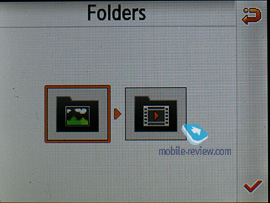


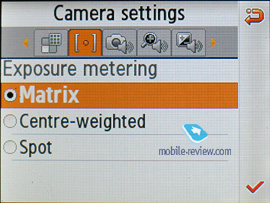




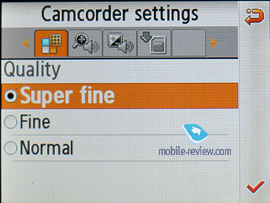

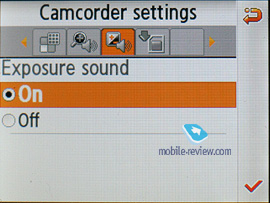
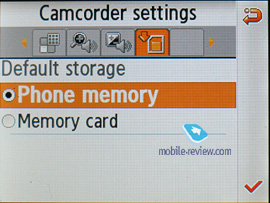
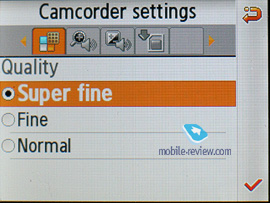
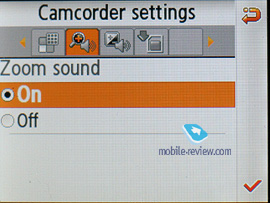




Shutter sound, as well as zoon sound can be disabled should you want it. The D900i’s camera includes 14x digital zoom feature, which is quite useless though, as exactly the same effect can be obtained by rendering it on PC. Brightness can be adjusted in the range from 1 to 6 (3 by default).
The camera also allows for your possible desire for overlaying special effects during shooting and offers White, Negative, Sepia, Emboss, Sketch, Antique, Moonlight, Fog. Taking account of the bundled picture editor proposing just the same functions, “spoiling” the initial photo with effects seems pointless.
Decorative frames are many, and can amplify the looks of your photo, but in return they reduce image size to 240x180 pixels.
The flash module adopted by the U600 employs LED technology, which means it can double as a flashlight as well (by working without a break). Effective distance for this flash is not too big, so that it works only for highlighting items located at short range.
The settings also enable you to set default name, customize sensitivity (Auto, ISO 100, ISO 200, ISO 400). Personally, I recommend that you use the Auto mode, since it performs quite well and gets the right parameters in most cases. On top of that there is no visible difference between abovementioned sensitivity levels in normal environment – there is no way you can spot changes produced by lower/higher sensitivity in that case. If you would like to take a group photo of your friends, but don’t want to be left out, set a Timer (3, 5 or 10 seconds).
The Mosaic mode downgrades resolution to the lowest one (final image makes 640x480 pixels in size), so that you could get a grid consisting of 4 or 9 pieces (2x2, 3x3). Generally speaking, it’s a mode for days when you feel like taking some fancy shots.

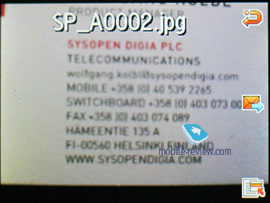






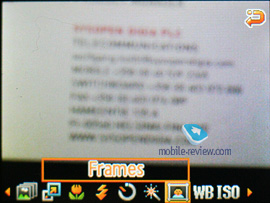

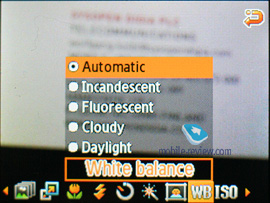
While in Multi shot mode, the camera snaps really fast, which makes it possible to acquire 6 pictures at a time (everything happens is an eyewink), in case this is not what you’re looking for, there is a normal mode as well (gap between shots – one second or a bit less). Modes with 9 and 15 pictures taken in series are also available. I’ve already said this and will repeat it again: this feature works fine for photo-finishes at tournaments etc., but in real life it won’t be of much use – when moving the handset most of shots get blurry. Resolution in this mode switches to 320x240 pixels.
All photos are stored in the Album, where you detailed data on every picture. Any image found in the Album can be assigned to a contact in the phonebook or set as wallpaper outright. Slide-show mode and a basic editor (allows applying emoticons, frames and special effects) are at your disposal. In terms of shots quality the camera is almost identical to Samsung D900, being tidy for this class.
The handset has support for capturing video in mpeg4 format either with or without sound (adjustable in menu). All settings almost precisely copy those for single shots – three quality levels, special effects, but different resolutions of clips. Maximum resolution is 355x288 pixels (15 frames per second), quality-wise the model resides in the leading group on the market and outdoes each and every handset in its class. Absence of an extra microphone for recording sound tracks (like on the D830) might affect recording quality.
Samsung u600 |
Sony ericsson k800i |
 |
 |
| (+) maximize, 2048x1536, JPEG |
(+) maximize, 2048x1536, JPEG |
 |
 |
| (+) maximize, 2048x1536, JPEG |
(+) maximize, 2048x1536, JPEG |
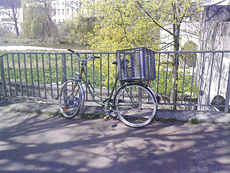 |
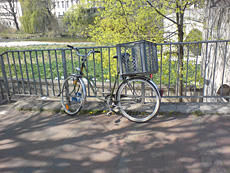 |
| (+) maximize, 2048x1536, JPEG |
(+) maximize, 2048x1536, JPEG |
 |
 |
| (+) maximize, 2048x1536, JPEG |
(+) maximize, 2048x1536, JPEG |
 |
 |
| (+) maximize, 2048x1536, JPEG |
(+) maximize, 2048x1536, JPEG |
 |
 |
| (+) maximize, 2048x1536, JPEG |
(+) maximize, 2048x1536, JPEG |
 |
 |
| (+) maximize, 2048x1536, JPEG |
(+) maximize, 2048x1536, JPEG |
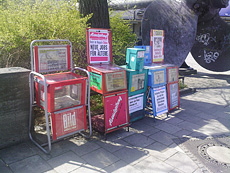 |
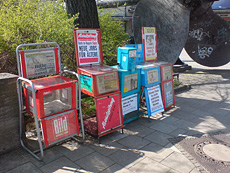 |
| (+) maximize, 2048x1536, JPEG |
(+) maximize, 2048x1536, JPEG |
 |
 |
| (+) maximize, 2048x1536, JPEG |
(+) maximize, 2048x1536, JPEG |
 |
 |
| (+) maximize, 2048x1536, JPEG |
(+) maximize, 2048x1536, JPEG |
 |
 |
| (+) maximize, 2048x1536, JPEG |
(+) maximize, 2048x1536, JPEG |
 |
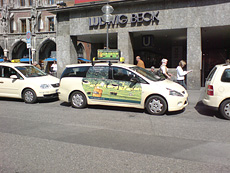 |
| (+) maximize, 2048x1536, JPEG |
(+) maximize, 2048x1536, JPEG |
 |
 |
| (+) maximize, 2048x1536, JPEG |
(+) maximize, 2048x1536, JPEG |
 |
 |
| (+) maximize, 2048x1536, JPEG |
(+) maximize, 2048x1536, JPEG |
Samsung u600 |
|
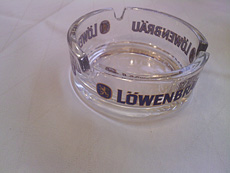 |
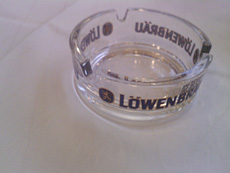 |
| (+) maximize, 2048x1536, JPEG |
(+) maximize, 2048x1536, JPEG |
 |
 |
| (+) maximize, 2048x1536, JPEG |
(+) maximize, 2048x1536, JPEG |
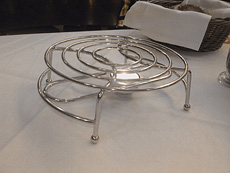 |
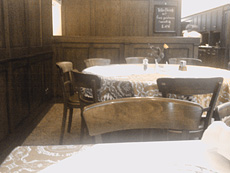 |
| (+) maximize, 2048x1536, JPEG |
(+) maximize, 2048x1536, JPEG |
 |
 |
| (+) maximize, 2048x1536, JPEG |
(+) maximize, 2048x1536, JPEG |
 |
 |
| (+) maximize, 2048x1536, JPEG |
(+) maximize, 2048x1536, JPEG |
 |
 |
| (+) maximize, 2048x1536, JPEG |
(+) maximize, 2048x1536, JPEG |
 |
 |
| (+) maximize, 2048x1536, JPEG |
(+) maximize, 2048x1536, JPEG |
 |
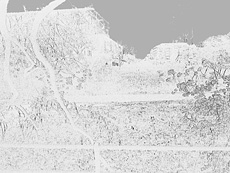 |
| (+) maximize, 2048x1536, JPEG |
(+) maximize, 2048x1536, JPEG |
 |
 |
| (+) maximize, 2048x1536, JPEG |
(+) maximize, 2048x1536, JPEG |
 |
 |
| (+) maximize, 2048x1536, JPEG |
(+) maximize, 2048x1536, JPEG |
 |
 |
| (+) maximize, 2048x1536, JPEG |
(+) maximize, 2048x1536, JPEG |
In terms of photo quality the camera is marginally different from that found on the Samsung D900/D900i, and is quite decent for its class.
Namercards recognition. One the options available with the camera is namecards recognition, meaning that you take a snap of a card, and then the handset moves all data it can catch into the phonebook. Obviously, at this stage, support for Russian language is missing, and when it comes to handling English, it performs not particularly smooth. But a part of the information will be recognized, that’s sure, so after some editing, you might even save some time.
Impressions
The reception quality put up by the U600 is in line with other Samsung-branded devices. The ringtone volume is quite decent, as it can be heard in various environments. The silent alert is average strength-wise, no significant improvements have been made here.
The new Samsung’s flagship has turned out to be very controversial, see for yourself – questionable ergonomics of the touch-sensitive buttons with their high wrong-press rate. On the downside, the phonebook’s fields can’t be sorted, while it may seem to be a subtle detail, yet it does deliver many hardships, as now you have to spend some time on re-organizing your data on PC. Lack of background mode for radio is a drawback as well, yet bearable.
The number of attractions in this handset is also quite large – the sound amplifier and decent sound quality along with the revamped player, average, yet still competent camera. Also on the upside is Smart Search, updated browser. For a fashion solution such rich functionality may feel superfluous in a way. In many respects Samsung’s current approach is similar to what Nokia is now doing with S60, though here we deal with a mere phone.
Bearing a 530-550 USD price tag, Samsung U600 is a good fashion solution. The filling the manufacturer has armed it with will get iterated on other models coming from the line-up, as the U600 is only the first sign. I can’t say how good you will feel about a device with such odd ergonomics – you will have to take it in hands and play with the phone for a couple of minutes. Actually this is that rare case, when judging without trying may prove to be completely wrong.
Review of GSM-handset Samsung U600 (Part 1) >>>
Eldar Murtazin (eldar@mobile-review.com)
Translated by Oleg Kononosov (oleg.kononosov@mobile-review.com)
Published — 15 May 2006
Have something to add?! Write us... eldar@mobile-review.com
|
News:
[ 31-07 16:21 ]Sir Jony Ive: Apple Isn't In It For The Money
[ 31-07 13:34 ]Video: Nokia Designer Interviews
[ 31-07 13:10 ]RIM To Layoff 3,000 More Employees
[ 30-07 20:59 ]Video: iPhone 5 Housing Shown Off
[ 30-07 19:12 ]Android Fortunes Decline In U.S.
[ 25-07 16:18 ]Why Apple Is Suing Samsung?
[ 25-07 15:53 ]A Few Choice Quotes About Apple ... By Samsung
[ 23-07 20:25 ]Russian iOS Hacker Calls It A Day
[ 23-07 17:40 ]Video: It's Still Not Out, But Galaxy Note 10.1 Gets An Ad
[ 19-07 19:10 ]Another Loss For Nokia: $1 Billion Down In Q2
[ 19-07 17:22 ]British Judge Orders Apple To Run Ads Saying Samsung Did Not Copy Them
[ 19-07 16:57 ]iPhone 5 To Feature Nano-SIM Cards
[ 18-07 14:20 ]What The iPad Could Have Looked Like ...
[ 18-07 13:25 ]App Store Hack Is Still Going Strong Despite Apple's Best Efforts
[ 13-07 12:34 ]Infographic: The (Hypothetical) Sale Of RIM
[ 13-07 11:10 ]Video: iPhone Hacker Makes In-App Purchases Free
[ 12-07 19:50 ]iPhone 5 Images Leak Again
[ 12-07 17:51 ]Android Takes 50%+ Of U.S. And Europe
[ 11-07 16:02 ]Apple Involved In 60% Of Patent Suits
[ 11-07 13:14 ]Video: Kindle Fire Gets A Jelly Bean
Subscribe
|













